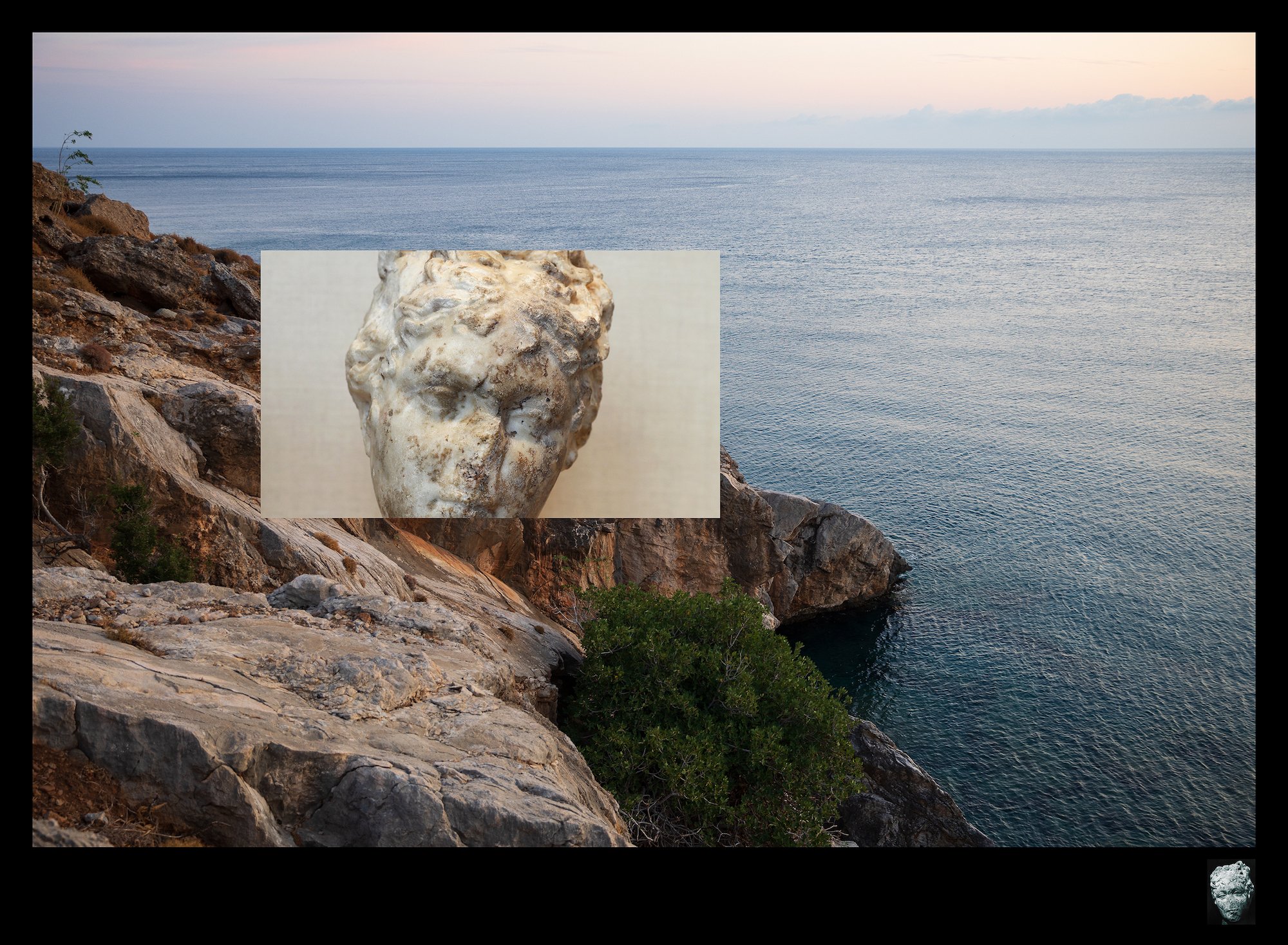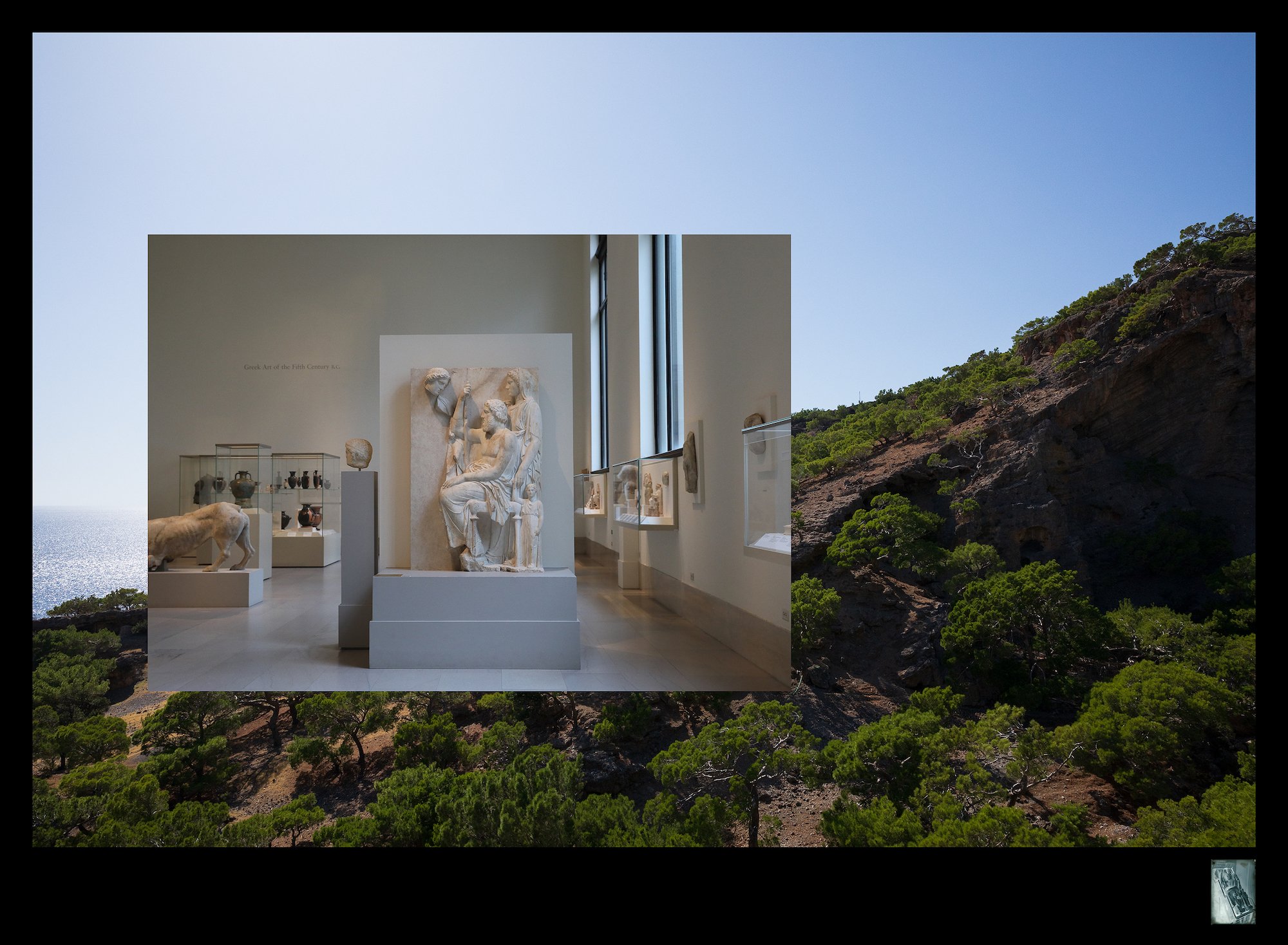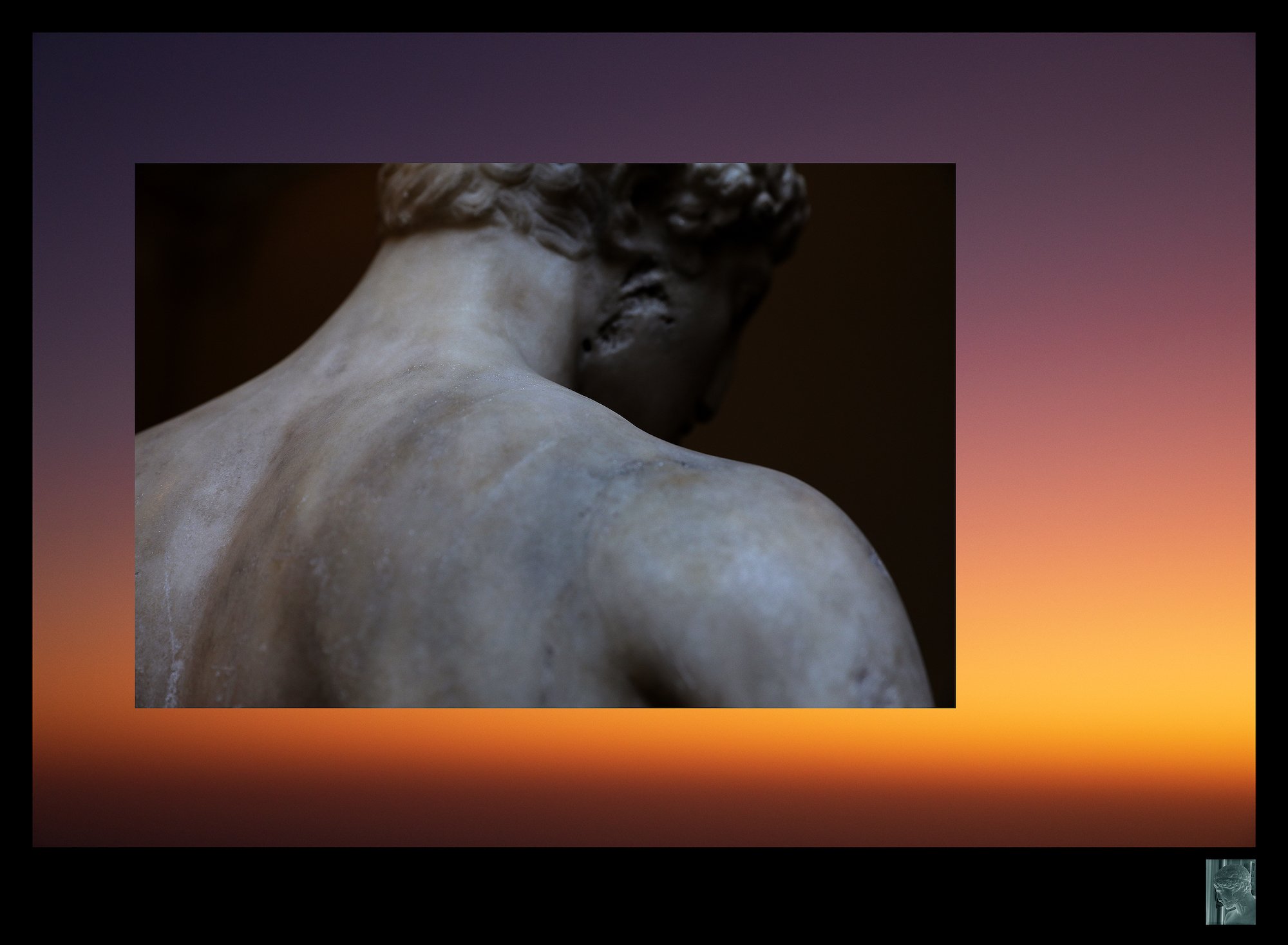Andrew Hazelwinkel, Journeys in the Lifeworld of Stones (Displacements I–X)
Andrew Hazelwinkel
Journeys in the Lifeworld of Stones (Displacements I–X)
Sumer
Waihirere Lane
(Spring Street access lane)
Tauranga CBD
Aotearoa (New Zealand)
29 January – 6 March 2022
Journeys in the Lifeworld of Stones (Displacements I–X) focuses on a selection of cultural artefacts now owned by the Metropolitan Museum of Art (Met). And includes archival material from the John Marshall Collection held at the British School at Rome. (Marshall was a scholar of Greek and Roman sculpture, who between 1906 and 1928 acted as the European agent for antiquities to the Met.)
At the lower margin of the photographs are digital reproductions of photographic negatives dating from the late 19th and early 20th century. These archivally-sourced images represent ancient objects—objects which were created as expressions of profound human emotion: love, celebration, loss. The inclusion of these images is key to Hazewinkel’s work, as is the knowledge that these images, and others like them, aided the acquisition of cultural artefacts by some of today’s largest universal museums, particularly at a time when New World institutions scrambled for Old World cultural legitimacy.
In each of the large, chromatically sumptuous and physically immersive photographic compositions that comprise this series we see the artist’s own photographs of those artefacts he first encountered as images in the archive, as they stand in the galleries of the Met today. By bringing together these two associated representations, and including related archive cataloguing data and accession numbers in the works’ titles, he highlights the moment when these ancient objects—originally connected with specific places and lives of others—became institutionalised. His materially grounded perspectives position this as a process of decontextualization, which for him is associated with the sense of loss that emanates from the displaced cultural artefacts that comprise the archaeological collections of universal museums.
Journeys in the Lifeworld of Stones (Displacements I–X) juxtaposes the truncated, flattened histories these objects now tell with photographs of grand landscapes, seascapes, sunsets and flora from the Mediterranean regions where the objects were originally made. By doing so he sheds light on the meanings, knowledge and understanding that are lost by their presence elsewhere; the body of work speaking to the current, nuanced, international discourse responding to the sometimes narrow perspective on the important matter of the repatriation of cultural objects.
Hazewinkel is interested in the contemporary social afterlife of ancient objects, stories and archetypes and the future-shaping roles they may play. This body of work weaves together his interests in the entangled relationships between materials, memory and the body, and the personal and social tensions that reside between damaged ancient figurative sculpture and our own soft ephemeral bodies.
— Sumer (exhibition text)
Andrew Hazelwinkel, Journeys in the Lifeworld of Stones (Displacement I) JM 758 / Met 11.100.2, 2010–2020, digital chromogenic print, Diasec acrylic facemounted, 116 x 158 cm, edition of 3 plus 1 AP. Courtesy of the artist and Sumer
Andrew Hazelwinkel, Journeys in the Lifeworld of Stones (Displacement II) JM 237 / Met 07.306, 2010–2020, digital chromogenic print, Diasec acrylic facemounted, 116 x 158 cm, edition of 3 plus 1 AP. Courtesy of the artist and Sumer
Andrew Hazelwinkel, Journeys in the Lifeworld of Stones (Displacement III) JMA.1.5.7/ Met 20.200, 2010–2020, digital chromogenic print, Diasec acrylic facemounted, 116 x 158 cm, edition of 3 plus 1 AP. Courtesy of the artist and Sumer
Andrew Hazelwinkel, Journeys in the Lifeworld of Stones (Displacement IV) JM 238 / Met 11.100.2, 2010–2020, digital chromogenic print, Diasec acrylic facemounted, 116 x 158 cm, edition of 3 plus 1 AP. Courtesy of the artist and Sumer
Andrew Hazelwinkel, Journeys in the Lifeworld of Stones (Displacement V) JM 548 / Met 27.45, 2010–2020, digital chromogenic print, Diasec acrylic facemounted, 116 x 158 cm, edition of 3 plus 1 AP. Courtesy of the artist and Sumer
Andrew Hazelwinkel, Journeys in the Lifeworld of Stones (Displacement VI) JM 777 / Met 26.60.2, 2010–2020, digital chromogenic print, Diasec acrylic facemounted, 116 x 158 cm, edition of 3 plus 1 AP. Courtesy of the artist and Sumer
Andrew Hazelwinkel, Journeys in the Lifeworld of Stones (Displacement VII) JM 702 / Met 23.69, 2010–2020, digital chromogenic print, Diasec acrylic facemounted, 116 x 158 cm, edition of 3 plus 1 AP. Courtesy of the artist and Sumer
Andrew Hazelwinkel, Journeys in the Lifeworld of Stones (Displacement VIII) JM 237 / Met 11.185 a-d,f,g.x, 2010–2020, digital chromogenic print, Diasec acrylic facemounted, 116 x 158 cm, edition of 3 plus 1 AP. Courtesy of the artist and Sumer
Andrew Hazelwinkel, Journeys in the Lifeworld of Stones (Displacement IX) JM 237 / Met 06.311, 2010–2020, digital chromogenic print, Diasec acrylic facemounted, 116 x 158 cm, edition of 3 plus 1 AP. Courtesy of the artist and Sumer
Andrew Hazelwinkel, ourneys in the Lifeworld of Stones (Displacement X) JM NN / Met 26.60.37, 2010–2020, digital chromogenic print, Diasec acrylic facemounted, 116 x 158 cm, edition of 3 plus 1 AP. Courtesy of the artist and Sumer
Andrew Hazelwinkel, Journeys in the Lifeworld of Stones (Displacements I–X). Installation view, Sumer, February 2021. Courtesy of the artist and Sumer
Andrew Hazelwinkel, Journeys in the Lifeworld of Stones (Displacement VIII) JM 237 / Met 11.185 a-d,f,g.x, 2010–2020, digital chromogenic print, Diasec acrylic facemounted, 116 x 158 cm, edition of 3 plus 1 AP. Courtesy of the artist and Sumer
Andrew Hazelwinkel, Journeys in the Lifeworld of Stones (Displacement VII) JM 702 / Met 23.69, 2010–2020, digital chromogenic print, Diasec acrylic facemounted, 116 x 158 cm, edition of 3 plus 1 AP. Courtesy of the artist and Sumer
Andrew Hazelwinkel, Journeys in the Lifeworld of Stones (Displacements I–X). Installation view, Sumer, February 2021. Courtesy of the artist and Sumer














